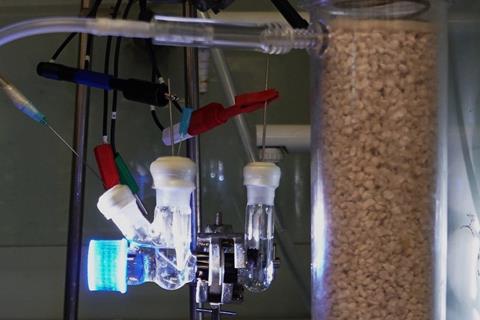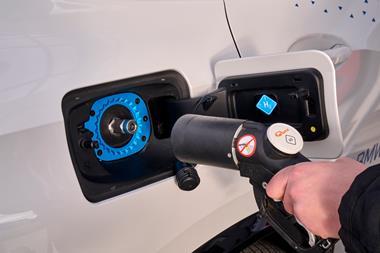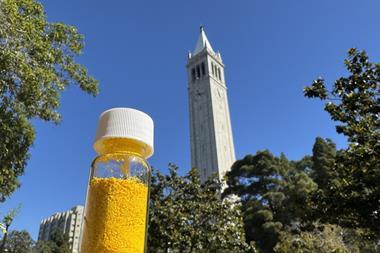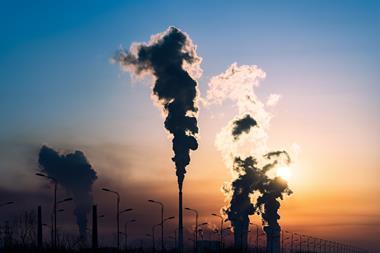
An integrated device has been developed that can convert carbon dioxide captured from the air into hydrogen and carbon monoxide using sunlight. This process coupled captured carbon dioxide reduction to the oxidation of plastic waste, generating the feedstock chemical glycolic acid to boot.
‘This is the first demonstration of connecting direct air capture of carbon dioxide with its direct utilisation in a solar-powered process, with everything in one device,’ says Erwin Reisner, who leads the group at the University of Cambridge. Carbon dioxide was captured from simulated flue gas or air using a standard amine/hydroxide solution under ambient conditions.
A perovskite-based photocathode with a cobalt–phthalocyanine catalyst generated syngas – carbon monoxide and hydrogen – from the captured carbon dioxide. At the dark anode, ethylene glycol from waste plastic polyethylene terephthalate was oxidised to glycolic acid over a copper–palladium alloy catalyst. Atmospheric carbon dioxide is tapped as the carbon source, while discarded plastic waste acts as an electron donor, and sunlight is the only energy input.
‘Generally, people used water oxidation as a conventional anode reaction, but our process can only be driven by plastic waste oxidation, which is a less thermodynamically demanding process,’ says Motiar Rahaman, a senior postdoc in the Cambridge lab.
Most prior processes, say the group, relied on concentrated streams of carbon dioxide. Whereas for this demonstration, the Reisner lab used flue gas with 15 to 20% carbon dioxide. They also successfully tested their device on carbon dioxide captured from the air. ‘We were surprised that this was actually possible,’ says Reisner.
The process runs at ambient conditions, producing the commodity chemical glycolic acid, used by the textile and cosmetics industry, and syngas, which can be turned into a liquid fuel using the Fischer-Tropsch process. Production was on µM/cm2 scale, with microlitres of products generated. ‘The next step is to make it more practical by going to concentrations that are more meaningful,’ says co-author Sayan Kar.

The team note that a net zero future will likely rely on recycling of atmospheric carbon dioxide to produce sustainable fuels and chemicals.
‘Each of these individual processes have been done, but this may be the first example where they’ve actually brought them all together in a single unified system,’ says David Heldebrant at the Pacific Northwest National Laboratory in Richland, Washington State. ‘They’re quite a few years away from actually having anything industrially relevant,’ he says. ‘I doubt there’s going to be any carbon capture plant that would bolt this on the back end, especially considering the small amounts of material here.’ A power plant can generate 500 tonnes of carbon dioxide an hour, he notes.
‘Talking about CO2 utilisation, anything is going to take a decade to half a decade to commercialise anything,’ says Heldebrant. ‘But other groups are working on different aspects of what they have here and there’s going to be improvements in the technology.’
Another paper from the Reisner group earlier this year demonstrated the use of three different catalysts – cobalt porphyrin, a copper indium alloy and a formate dehydrogenase enzyme – to reduce carbon dioxide into carbon monoxide, syngas or formate, respectively.
‘Carbon capture and storage (CCS) is very popular with the fossil industry because it allows them to continue with fossil extractions, capture CO2 and store it underground, though the process also consumes a huge amount of energy,’ says Reisner. ‘But this is a nice demonstration of how carbon capture could be linked to green fuel synthesis, which makes could make CCS a meaningful technology that’s free from the fossil industry.’
‘In the short to medium term, we need to couple such devices to flue gas or fermenters, where you can use very high concentrations of CO2,’ says Reisner. ‘But in the long run we need to close the carbon cycle and take CO2 from air. Certainly, we need these technologies by 2050.’
References
S Kar et al, Joule, 2023, DOI: 10.1016/j.joule.2023.05.022

















No comments yet